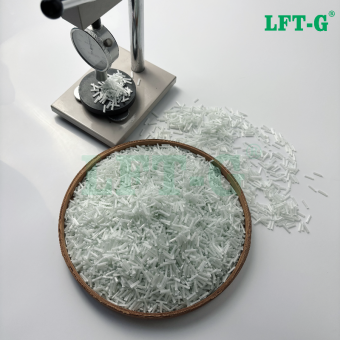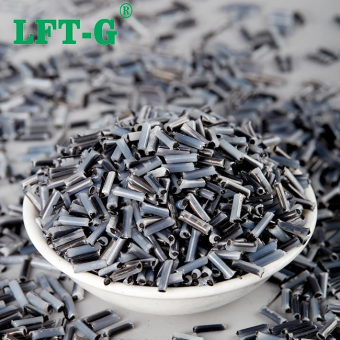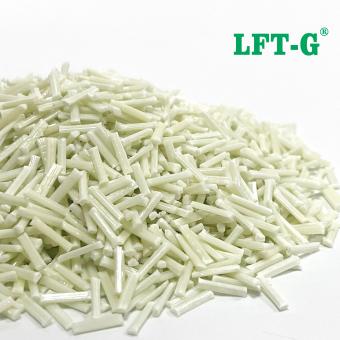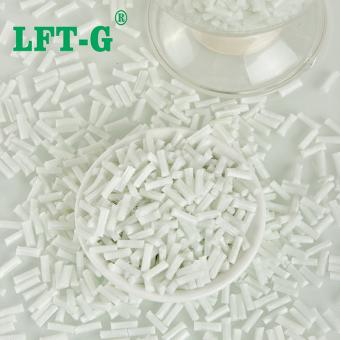-
LFT HDPE LGF40 مركب الألياف الزجاجية المقوى للأنابيباسم المنتج: HDPE LGF40 ، البولي إيثيلين عالي الكثافة LGF40 ، تعبئة الألياف الزجاجية الطويلة HDPE استمارة:H متانة التأثير والمقاومة الكيميائية وثبات الأبعاد العالية ميزة: معمل خاص للاختبار
- HDPE LGF40
- مركب LFT HDPE
- البولي إيثيلين عالي الكثافة LGF40
- الألياف الزجاجية الطويلة ملء HDPE
- قوة شد عالية HDPE GF40
- HDPE البلاستيك المقوى بالألياف الزجاجية
علامات :
-
LFT-G HDPE يملأ ألياف زجاجية طويلة صلابة عالية وصلابة بلاستيكية معدلة للقذيفةHDPE Introduction High-density polyethylene is an opaque white waxy material, lighter than water, specific gravity of 0.941 ~ 0.960, soft and tough, but slightly harder than LDPE, but also slightly elongated, non-toxic, odorless. Flammable, can continue to burn after leaving the fire, the upper end of the flame is yellow, the lower end is blue, will melt when burning, there are liquid drops, no black smoke, at the same time, emitting the smell of paraffin wax when burning. Acid and alkali resistance, organic solvent resistance, excellent electrical insulation, low temperature, can still maintain a certain degree of toughness. Surface hardness, tensile strength, rigidity and other mechanical strength are higher than LDPE, close to PP, tougher than PP, but the surface finish is not as good as PP. Poor mechanical properties, poor air permeability, easy to deformation, easy to aging, easy to brittle, brittle than PP, easy stress cracking, low surface hardness, easy to scratch. Difficult to print, when printing, surface discharge treatment is required, can not be plated, and the surface is not glossy. HDPE-Long glass fiber Because of its high crystallinity, poor impact strength and environmental cracking resistance and other defects, limiting its scope of application, so a lot of toughening modification HDPE research work has been carried out at home and abroad. Our company has greatly improved the performance of HDPE through the way of co-blending modification. Long fiber reinforced thermoplastic composites are reinforced thermoplastics with fiber lengths greater than 10mm. The reinforcing fibers are mainly glass fibers, carbon fibers, etc. Depending on the type of resin with appropriate fiber surface treatment, better results can be achieved. The addition of fiber material to the resin can greatly improve the overall material performance. Fiber composites absorb external forces in three ways: fiber pullout, fiber breakage, and resin fracture. The increase of fiber length consumes more energy for fiber pull-out, which is beneficial to the improvement of impact strength; the end of fiber in the composite is often the initiation point of crack growth, and the small number of long fiber ends also makes the impact strength increase; the long fiber blends entangle, flip and bend each other when filling the mold, unlike the short fiber blends which are arranged in the flow direction, therefore, the long fiber blends molded products are better than the same molded parts of short fiber blends. Therefore, compared with the same molded parts of short fiber blends, the long fiber blends have higher isotropy, better straightness, less warpage, and therefore better dimensional stability; the heat deflection temperature of long fiber reinforced thermoplastics is also increased than that of short fiber blends. Therefore, long-fiber composites exhibit better performance than short-fiber composites, which can improve rigidity, compression strength, bending strength, and creep resistance. Process TDS for your reference Tests Certifications Quality Management System ISO9001/16949 Certification National Laboratory Accreditation Certificate Modified Plastics Innovation Enterprise Honorary Certificate Heavy metal REACH & ROSH testing Application We will provide technical supports according to your product's images. About us We will offer you: 1. LFT & LFRT material technical parameters and leading edge design. 2. Mold front design ang recommendations. 3. Provide technical support such as injection molding and extrusion molding. Frequently asked questions Q: How to choose the reinforcement method and length of the material when using long fiber reinforced thermoplastic material? ج: اختيار المواد يعتمد على متطلبات المنتجات. من الضروري تقييم مقدار تعزيز المحتوى ومقدار الطول الأكثر ملاءمة ، والذي يعتمد على متطلبات أداء المنتجات. س: بالإضافة إلى كونها مناسبة للقولبة بالحقن ، يمكن بثق منتجات الألياف الطويلة أو عمليات أخرى؟ ج: تُستخدم الألياف الزجاجية الطويلة LFT وألياف الكربون الطويلة بشكل أساسي لقولبة الحقن ، ويمكنها أيضًا أنبوب البثق للوحة وحواف القالب بمجموعة متنوعة من طرق التشكيل بالحرارة. س: تكلفة منتجات الألياف الطويلة أعلى من تكلفة المواد الخام. هل لها قيمة إعادة تدوير عالية؟ ج: يمكن إعادة تدوير مادة الألياف الطويلة البلاستيكية الحرارية وإعادة استخدامها بشكل جيد للغاية.
- ألياف زجاجية طويلة HDPE
- طويلة من اللدائن الحرارية المقواة بالألياف
- حبيبات البلاستيك المقوى بالألياف الزجاجية
- مركب LFT
- HDPE LGF
- الألياف الزجاجية ملء الكثافة
علامات :
-
شيامن LFT-G HDPE يملأ الكريات الطويلة المصنوعة من الألياف الزجاجية ذات الصلابة العالية والصلابة المعدلة للقذيفةمقدمة HDPE البولي إيثيلين عالي الكثافة عبارة عن مادة شمعية بيضاء غير شفافة، أخف من الماء، الثقل النوعي 0.941 ~ 0.960، ناعم وقوي، ولكنه أصعب قليلاً من LDPE، ولكنه أيضًا ممدود قليلاً، وغير سام، وعديم الرائحة. قابل للاشتعال، يمكن أن يستمر في الاحتراق بعد ترك النار، الطرف العلوي للهب أصفر، الطرف السفلي أزرق، سوف يذوب عند الاحتراق، هناك قطرات سائلة، لا يوجد دخان أسود، في نفس الوقت، تنبعث منها رائحة البارافين. الشمع عند الاحتراق. مقاومة الأحماض والقلويات، ومقاومة المذيبات العضوية، والعزل الكهربائي الممتاز، ودرجة الحرارة المنخفضة، لا تزال قادرة على الحفاظ على درجة معينة من المتانة. صلابة السطح، وقوة الشد، والصلابة والقوة الميكانيكية الأخرى أعلى من LDPE، قريبة من PP، وأكثر صرامة من PP، ولكن تشطيب السطح ليس جيدًا مثل PP. خصائص ميكانيكية سيئة، نفاذية هواء سيئة، سهل التشوه، سهل الشيخوخة، سهل الهشاشة، هش من PP، تكسير سهل الإجهاد، صلابة سطح منخفضة، سهل الخدش. من الصعب الطباعة، عند الطباعة، يلزم معالجة تفريغ السطح، ولا يمكن طلاؤه، والسطح غير لامع. HDPE-ألياف زجاجية طويلة ب بسبب تبلورها العالي وضعف قوة التأثير ومقاومة التكسير البيئي والعيوب الأخرى، مما يحد من نطاق تطبيقها، لذلك تم إجراء الكثير من أعمال البحث الخاصة بتعديل HDPE في الداخل والخارج. لقد قامت شركتنا بتحسين أداء HDPE بشكل كبير من خلال تعديل المزج المشترك. مركبات اللدائن الحرارية المقواة بالألياف الطويلة هي لدائن حرارية معززة بأطوال ألياف أكبر من 10 مم. ألياف التسليح هي بشكل رئيسي ألياف زجاجية، ألياف كربون، إلخ. اعتمادًا على نوع الراتنج مع المعالجة السطحية المناسبة للألياف، يمكن تحقيق نتائج أفضل. يمكن أن تؤدي إضافة مادة الألياف إلى الراتينج إلى تحسين الأداء العام للمادة بشكل كبير. تمتص مركبات الألياف القوى الخارجية بثلاث طرق: سحب الألياف، وكسر الألياف، وكسر الراتنج. زيادة طول الألياف تستهلك المزيد من الطاقة لسحب الألياف، وهو أمر مفيد لتحسين قوة التأثير؛ غالبًا ما تكون نهاية الألياف في المركب هي نقطة بدء نمو الكراك، كما أن العدد الصغير من نهايات الألياف الطويلة يؤدي أيضًا إلى زيادة قوة التأثير؛ تتشابك خلطات الألياف الطويلة وتقلب وتنحني عند ملء القالب، على عكس خلطات الألياف القصيرة التي يتم ترتيبها في اتجاه التدفق، لذلك فإن منتجات خلطات الألياف الطويلة أفضل من نفس الأجزاء المصبوبة من خلطات الألياف القصيرة. لذلك، بالمقارنة مع نفس الأجزاء المقولبة من خلائط الألياف القصيرة، فإن خلائط الألياف الطويلة لها نظير أعلى، واستقامة أفضل، واعوجاج أقل، وبالتالي استقرار أفضل للأبعاد؛ يتم أيضًا زيادة درجة حرارة انحراف الحرارة لللدائن الحرارية المقواة بالألياف الطويلة عن تلك الخاصة بمزيج الألياف القصيرة. ولذلك، فإن مركبات الألياف الطويلة تظهر أداء أفضل من مركبات الألياف القصيرة، والتي يمكن أن تحسن الصلابة، وقوة الضغط، وقوة الانحناء، ومقاومة الزحف. عملية TDS للرجوع إليها الاختبارات الشهادات شهادة نظام إدارة الجودة ISO9001/16949 شهادة اعتماد المختبرات الوطنية مؤسسة الابتكار في مجال البلاستيك المعدل شهادة فخرية اختبار الوصول إلى المعادن الثقيلة وROSH طلب سوف نقدم الدعم الفني وفقًا لصور منتجك. مع
- الألياف الزجاجية الطويلة HDPE بدلاً من المعدن والصلب
- LFT مركب PE للأنابيب تحت الأرض
- قالب حقن عينة HDPE LGF متاح
- تعبئة الألياف الزجاجية من الدرجة العذراء hdpe
علامات :

 البريد الإلكتروني
البريد الإلكتروني العربية
العربية English
English français
français Deutsch
Deutsch русский
русский italiano
italiano español
español português
português 日本語
日本語 한국의
한국의 中文
中文













